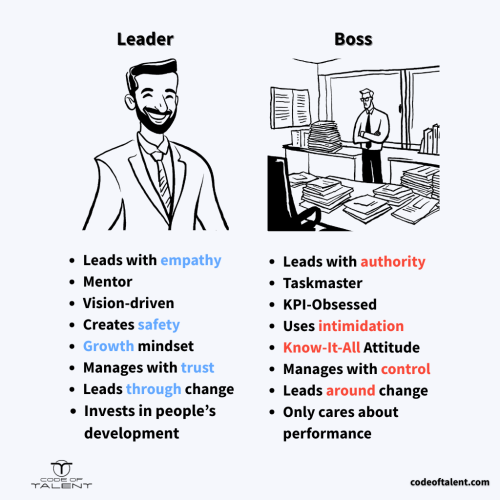The cost of turnover due to toxic leadership amounted to $223 billion between 2014 and 2019. Despite this number, many organizations continue to promote high-performing employees into management roles without investing in the leadership skills and qualities that prepare them to be great leaders.
These new managers often excel at completing their managerial tasks but lack the emotional intelligence (EQ), skills, and mindset to truly lead. They manage work but don’t inspire people. They measure performance but don’t develop potential. And in time, some of them develop traits that lead them to become the traditional “toxic boss” figure, the one that drives people away and creates a company culture of instability.
The “toxic boss” damage is well documented:
- A LinkedIn market research for 2024 found that 7 in 10 U.S. workers would quit because of their toxic manager, with Millennials and Gen-z leading the numbers (77% and 75%, respectively)
- A 2019 DDI study revealed that 57% of workers left a job because of their bosses
- A Robert Half survey found that 49% of U.S. employees did the same.
Combat Toxic Leadership with the Correct Leadership Skills and Qualities
Toxic leadership can be prevented with the right training and a shift in mindset. Here are eight leadership skills and qualities that set great leaders apart from everyday bosses—traits that should be at the core of every leadership development program.

1. Leads with Empathy, Not Authority
Empathy is often dismissed as “soft,” but in leadership, it’s a power skill. It’s what allows a leader to understand their team members on a deeper level, both as employees and human beings. A manager leading with empathy can anticipate resistance within the team and respond to emotional dynamics, either positive or negative, that may influence performance.
Being emphatic as a manager doesn’t mean being permissive, though. In a 2022 Businessolver study, 77% of the interviewed CEOs said they would lose respect if they’re too empathetic, and 79% said they struggle to be empathetic, highlighting that empathy is one of the most misunderstood skills for leadership development.

Boss:
- Operates from authority
- Makes decisions without consulting with the team and expects them to comply
- Views emotions as irrelevant or inconvenient
- Communication is only for work
- Doesn’t respect their team members’ boundaries
Leader:
- Practices active listening
- Acknowledges team members’ emotions, needs, and aspirations
- Uses empathy to motivate, not manipulate
- Creates space for open dialogue, even when conversations are uncomfortable
2. Acts as a Coach, Not a Taskmaster
While bosses often focus on giving instructions and correcting mistakes, real leaders act as coaches, supporting their team members in building confidence, discovering their strengths, and solving challenges on their own. Studies show that leaders who take a coaching approach help improve employee engagement as people feel more energized, committed, and focused at work.
In the long run, coaching builds confidence and loyalty between a manager and their direct reports. The leader is no longer seen as a vehicle of control but a mentor or friend.

Boss:
- Hands off tasks to lighten their own load
- Focuses only on getting results
- Offers little feedback, and when they do, it’s usually just to correct mistakes
- Only trains team members during onboarding or when required by the company
Leader:
- Asks guiding questions
- Creates teachable moments from mistakes
- Celebrates employees’ growth, not just output
- Delegates tasks with growth in mind rather than completion
- Mentors team members in all stages of their employment, not just during onboarding
3. Vision-Driven, Not KPI-Obsessed
A PwC study on purpose in the workplace reveals a major leadership gap: while 79% of leaders believe purpose is central to success, only 34% of employees feel connected to that purpose. Executives often see the in commercial values such as profit, growth, market share, while employees look for meaning in their individual impact.
The problem is that many managers lack a clear vision. They focus on KPIs and short-term performance and rarely on inspiring their teams or connecting work to a bigger mission.

Boss:
- Fixates on numbers
- Drives teams to meet short-term KPIs without explaining why
- Often causes burnout to complete goals that feel meaningless
Leader:
- Communicates a bigger picture
- Helps people understand why their work matters
- Uses KPIs as guidelines, not goals in themselves
- Inspires through mission, not pressure
4. Psychological Safety, Not Intimidation
Google’s Project Aristotle identified psychological safety as the #1 predictor of team effectiveness across the company. When team members feel safe to speak openly without fear of embarrassment or punishment, they’re more likely to share ideas, admit mistakes, and ask questions.
A great leader builds the foundation for such safety through their interactions with their team members. They don’t shout or get angry, and they answer with empathy to their problems and offer moral support in times of need. More often than not, great leaders are not afraid to be vulnerable themselves with their team. Sharing fears and frustrations with their direct reports can build a sense of trust and relatability.

Boss:
- Leads with control
- Uses fear to maintain authority
- Mistakes are punished, not analyzed
- Team members hold back from being open with them out of fear for being fired, judged, or ridiculed
Leader:
- Creates a safe space for questions and vulnerability
- Encourages experimentation
- Treats failure as part of learning
- Asks for input from every voice in the room, not just the loudest.
5. Growth Mindset, Not Know-It-All Attitude
Great leaders understand that learning never stops. An International Institute for Management Development article recognizes the importance of continuous learning for leaders, claiming that the commitment to ongoing learning not only enhances the managers’ own capabilities but also sets a powerful example for their teams.
It’s easy for employees to want to learn on their own once they see their manager hungry for knowledge. It’s often an unconscious response: whether they want to impress their leader, match their pace, or avoid falling behind. A motivated leader sets the ground for a high-achieving team.

Boss:
- Relies too much on past experience
- Avoids feedback
- Sees learning as a sign of weakness
- Dismisses new ideas
Leader:
- Follows a growth mindset
- Admits when they don’t know something
- Seeks diverse perspectives and invests in their own learning
- Attends training themselves on various areas such as upskilling or leadership
6. Manages with Trust, Not Control
Over-control describes a toxic boss best. It kills motivation and breeds discomfort and disengagement among the team. While bosses often feel the need to control every detail, true leaders know that trust is a more powerful motivator.
Managing with trust means creating a space where people feel empowered to take ownership of their work. According to Harvard Business Review, providing employees with autonomy significantly reduces stress and increases engagement. In fact, employees are 43% less likely to experience burnout when they have more control over their work. They learn from their mistakes, take pride in their accomplishments, and inspire others.

Boss:
- Oversees every detail so that things are done “their way”
- Constantly checks in because they don’t trust their team members to succeed on their own
- Want to control everything, from important decisions to day-to-day tasks
- Teams become dependent on their input
Leader:
- Sets clear goals, then gets out of the way
- Provides support, not surveillance
- Steps in when needed, but doesn’t hover
- Focuses on outcomes, not control
7. Leads Through Change, Not Around It
In times of uncertainty, like layoffs, budget cuts, or restructuring, a team manager is a pillar of support and trust for their team. A great leader does this with confidence and clarity: communicates with transparency, acknowledges concerns, and helps the team find meaning and direction. They don’t hide from hard conversations or sugarcoat the truth; instead, they guide their team with a clear vision of what comes next.
A boss, however, avoids tough conversations or shares news coldly. Focused only on output, they ignore morale and often go silent when support is most needed. Instead of being a source of stability, they become another stressor.

Boss:
- Delivers uncomfortable information with detachment, often following a checklist
- Doesn’t know how to explain the changes or avoids explaining them completely
- Can’t read the emotional cues and is fixated on productivity rather than employees’ well-being
- Creates confusion and resistance
Leader:
- Communicates the “why” of change clearly
- Involves teams in problem-solving
- Is open about challenges and adaptive in approach
- Listens to employees’ concerns and tries to find solutions to better adapt to the change
8. Invests in People’s Development, Not Just Performance
True leaders truly care about their team’s growth, not just because it benefits performance, but because they believe in people’s potential. They encourage people to take on additional tasks and professional development opportunities, even if it means challenging outdated systems. They know that investing in people’s development is a long-term benefit for the individuals, team, organization, and their confidence as leaders.
Development and growth opportunities are main reasons why employees stay at a company and excel. LinkedIn’s 2019 Workforce Learning Report found that 94% of employees say that they would stay at a company for a longer period of time if that company invested in helping them learn. So, it’s a leader’s job to make sure this opportunity doesn’t go wasted.

Boss:
- Protects the status quo
- May resist change
- Keeps people in roles they’ve outgrown out of fear of being overshadowed or changing “how things are done”
- Sees training as another administrative requirement rather than an opportunity for growth
Leader:
- Encourages employees to attend training and learning opportunities to upskill beyond their job description
- Helps team members grow into new roles
- Embraces change as a way to improve
- Supports personal development goals
- Builds a team culture where learning is valued and rewarded
Integrating Leadership Skills and Qualities in Training, The Right Way
Recognizing the difference between bosses and leaders is a start, but the real impact comes with including these all of the above-mentioned skills into everyday learning practically, consistently, and efficiently.
The Issues with Common Leadership Training
Too many leadership programs rely on passive learning and abstract concepts. According to a study on leadership training programs from 2023 by the Association of Talent Development, while 77% of organizations offer leadership development programs, many still face critical challenges. Among those with active programs:
- 92% say lack of time for leaders to participate is the biggest barrier
- 74% report insufficient budget for quality training
- 72% struggle with measuring the effectiveness of their programs
Leadership Training Done Right
In essence, common leadership training programs fail to change behaviors because they aren’t applied in context. There are so many ways to improve a leadership program, but here are some features to consider:
- On-the-job training (OJT): Learn anytime, anywhere, which is ideal for busy schedules.
- Personalized learning experiences: Tailored content based on roles, goals, and skills.
- Scenario-based exercises: Perfect to practice soft skills through real-world simulations.
- Technical skills training: Focused modules for job-specific tools and tasks.
- Compliance training: Up-to-date content on company policies and procedures.
- Collaborative learning: Peer discussions and shared activities to learn from other and encourage camaraderie.
- Feedback exercises: Practice for delivering effective and empathetic feedback.
- Real-time tracking: Instant insights on learner progress and performance.
- Engaging content (e.g., microlearning): Short, impactful lessons that fit busy days.
If you want to deliver training that includes all these features, from microlearning and scenario-based exercises to real-time tracking and collaborative learning, Code of Talent is built for exactly that.
It’s a smart, scalable way to help your managers develop the leadership skills and qualities that drive real impact. Discover how Code of Talent can power your leadership programs and try our free trial on upskilling to meet every training need!





